| Lueders Formation | |
|---|---|
| Stratigraphic range: Early Permian | |
 Exposure in Wilbarger County, Texas (1908). | |
| Type | Geological formation |
| Unit of | Albany Group |
| Sub-units |
|
| Underlies | Clear Fork Group[1] |
| Overlies | Talpa Formation[1] |
| Thickness | 50 to 70 feet[1] |
| Lithology | |
| Primary | Interbedded shale & limestone[1] |
| Location | |
| Region | |
| Country | |
| Type section | |
| Named for | Lueders, Texas |
The Lueders Formation is a geologic formation in Texas. It is the top formation of the Albany Group and preserves fossils dating back to the Permian period.[1]
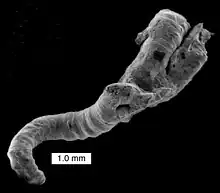
Description
Paleogeography
At the time of deposition, a broad sea connected to the Panthalassic Ocean covered much of the central United States, including Texas. The Lueders Formation would have been located in the northern tropics or subtropics. Climatically, after the retreat of an early Artinskian glacial maximum, the deserts of the North American craton experienced fluctuation and growth during this time period, and the associated aridity decrease impacted seabed deposition in localities across the basin.[2]
Depositional environment
The Lueders Formation represents a deltaic environment, with terrestrial sediments being deposited onto the muddy bottom of a shallow estuary by shifting freshwater streams. In the Maybelle Member, the dolomite likely represents marine deposits, preserving marine sharks and fish, whereas darker terrestrial sediments and freshwater shale deposits contain remains of land animals and freshwater fish respectively.[3]
Fossil content
Amphibians
| Amphibians reported from the Lueders Formation | |||||
|---|---|---|---|---|---|
| Genus | Species | Presence | Material | Notes | Images |
| Crossotelos | C. annulatus | Maybelle Member.[4] | Multiple specimens.[4] | A nectridean. | |
| Diplocaulus | D. magnicornis | Maybelle Member.[3] | Multiple specimens.[3] | A nectridean. | .png.webp) |
| Eryops | E. megacephalus | Maybelle Member.[3] | Limb & skull elements.[3] | An eryopid. | 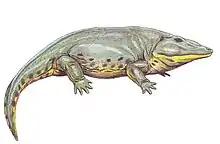 |
| Trimerorhachis | T. sp. | Maybelle Member.[3] | Limb & skull elements.[3] | A dvinosaur. |  |
Fish
Acanthodians
| Acanthodians reported from the Lueders Formation | |||||
|---|---|---|---|---|---|
| Genus | Species | Presence | Material | Notes | Images |
| Acanthodes | A. sp. | Maybelle Member.[3] | A fin spine.[3] | An acanthodiform, known from freshwater deposits. |  |
Bony fish
| Bony fish reported from the Lueders Formation | |||||
|---|---|---|---|---|---|
| Genus | Species | Presence | Material | Notes | Images |
| "Acrolepis" | Maybelle Member.[3] | Scales.[3] | A palaeonisciform. | 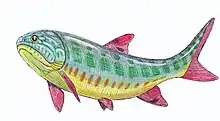 | |
| Gnathorhiza | G. serrata | Maybelle Member.[3][5] | Jaw elements & near-complete specimen.[3][5] | A lungfish from freshwater deposits. | 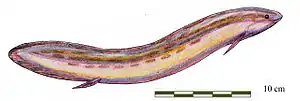 |
| Lawnia | L. cf. L. taylorensis | Maybelle Member.[3][6] | Remains of millions of individuals.[3] | A palaeonisciform originally reported as 'Lawnia-like', now thought to represent the genus itself.[6] | |
| Luederia | L. kempi | Maybelle Member.[3][6] | A braincase & 2 large cleithra.[3][7] | A marine palaeonisciform. | |
| ?Platysomus | ?P. palmaris | Maybelle Member.[3] | Partial bodies & numerous scales.[3] | A marine (?) palaeonisciform. | |
| Sagenodus | Maybelle Member.[5] | Upper tooth plate (UCLA VP 431).[5] | A lungfish. | 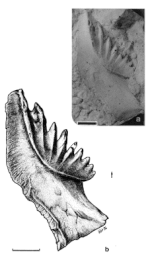 | |
| Schaefferichthys | S. leudersensis | Maybelle Member.[3] | Incomplete specimen (USNM 23109).[3][8] | A freshwater palaeonisciform. | 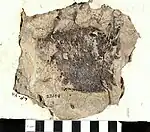 |
| ?Spermatodus | ?S. pustulosus | Maybelle Member.[3] | Multiple specimens.[3] | A coelacanth. | |
Cartilaginous fish
| Cartilaginous fish reported from the Lueders Formation | |||||
|---|---|---|---|---|---|
| Genus | Species | Presence | Material | Notes | Images |
| Acrodus | ?A. olsoni | Teeth.[9] | A hybodont. | ||
| ?A. sweetlacruzensis | Teeth.[9] | A hybodont. | |||
| Barbclabornia | B. luedersensis | Numerous teeth.[10] | A giant freshwater xenacanth. | 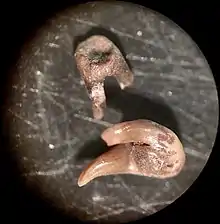 | |
| Ctenacanthus | C. cf. C. amblyxiphias | Maybelle Member.[3] | Fin spines.[3] | A ctenacanth found in the marine dolomite. |  |
| Janassa | J. sp. | Maybelle Member.[3] | Isolated teeth.[3] | A petalodont found in the marine dolomite. | 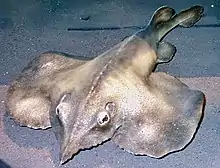 |
| Orthacanthus | O. platypternus | Teeth.[11] | A freshwater xenacanth. | ||
| O. texensis | Teeth.[11] | A freshwater xenacanth. | 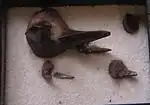 | ||
| Polyacrodus | P. wichitaensis | Teeth.[9] | A hybodont. | ||
| P. zideki | Teeth.[9] | A hybodont. | |||
| Xenacanthus | ?X. slaughteri | Teeth.[11] | A freshwater xenacanth. | ||
| X. sp. | Maybelle Member.[3] | A tooth.[3] | A freshwater xenacanth. | 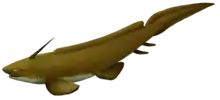 | |
Synapsids
| Synapsids reported from the Lueders Formation | |||||
|---|---|---|---|---|---|
| Genus | Species | Presence | Material | Notes | Images |
| Dimetrodon | D. sp. | Maybelle Member.[3] | Neural spine & bone fragments.[3] | A sphenacodontid. |  |
Invertebrates
Arthropods
| Arthropods reported from the Lueders Formation | |||||
|---|---|---|---|---|---|
| Genus | Species | Presence | Material | Notes | Images |
| Ostracoda indet. | Indeterminate | WSU 1445.[2] | A fragmentary ostracod. | ||
| Panduralimulus | P. babcocki | Maybelle Member.[12] | Multiple specimens.[12] | A horseshoe crab. | |
Bivalves
| Bivalves reported from the Lueders Formation | |||||
|---|---|---|---|---|---|
| Genus | Species | Presence | Material | Notes | Images |
| Myalinella | M. sp. | Valves (WSU 1407).[2] | A myalinid. | ||
| Pinnidae indet. | Indeterminate | Shell.[2] | An unknown pen shell. | ||
Bryozoans
| Bryozoans reported from the Lueders Formation | |||||
|---|---|---|---|---|---|
| Genus | Species | Presence | Material | Notes | Images |
| Bryozoa indet. | Indeterminate | WSU 1430.[2] | A fragmentary bryozoan. | ||
Cephalopods
| Cephalopods reported from the Lueders Formation | |||||
|---|---|---|---|---|---|
| Genus | Species | Presence | Material | Notes | Images |
| Koninckioceras | K. bibbi | Internal mold.[13] | A nautiloid. | ||
| Metacoceras | M. sp. | Shell (WSU 1437).[2] | A nautiloid. | 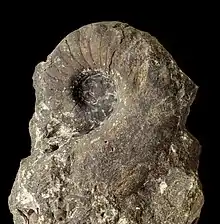 | |
| Michelinoceras | M. sp. | Phragmocone (WSU 1406).[2] | A orthocerid. | 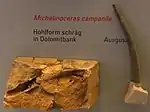 | |
| Millkoninckioceras | M. sp. | Shell (WSU 1442).[2] | A nautiloid. | ||
| Perrinitidae indet. | Indeterminate | 3 specimens.[2] | An ammonite. | ||
| Stenopoceras | cf. S. whitei | Phragmocone.[2] | A nautiloid. | ||
Echinoderms
| Echinoderms reported from the Lueders Formation | |||||
|---|---|---|---|---|---|
| Genus | Species | Presence | Material | Notes | Images |
| Crinoidea indet. | Indeterminate | Columnal (WSU1405A).[2] | A fragmentary crinoid. | ||
Plants
| Plants reported from the Lueders Formation | |||||
|---|---|---|---|---|---|
| Genus | Species | Presence | Material | Notes | Images |
| Tinsleya | T. texana | Maybelle Member.[14] | Numerous specimens.[14] | A pteridosperm. | |
| Zeilleropteris | Z. wattii | Leaves.[15] | A gigantopterid. | ||
See also
References
- 1 2 3 4 5 "Geolex — Lueders publications". ngmdb.usgs.gov. Retrieved 2023-07-25.
- 1 2 3 4 5 6 7 8 9 10 11 Shell, Ryan; Peterman, David; Ciampaglio, Charles; Armstrong, Adam; Laurene Fuelling (2020). "A fossil molluscan fauna from the lower Lueders Formation of north-central Texas". doi:10.13140/RG.2.2.15600.81924.
{{cite journal}}: Cite journal requires|journal=(help) - 1 2 3 4 5 6 7 8 9 10 11 12 13 14 15 16 17 18 19 20 21 22 23 24 25 26 27 28 29 30 31 Dalquest, Walter W.; Kocurko, M. John (1986). "Geology and Vertebrate Paleontology of a Lower Permian Delta Margin in Baylor County, Texas". The Southwestern Naturalist. 31 (4): 477–492. doi:10.2307/3671702. ISSN 0038-4909. JSTOR 3671702.
- 1 2 Carlson, Keith J. (1999). "Crossotelos, an Early Permian Nectridean Amphibian". Journal of Vertebrate Paleontology. 19 (4): 623–631. ISSN 0272-4634. JSTOR 4524033.
- 1 2 3 4 Berman, David S. (1968). "Lungfish from the Lueders Formation (Lower Permian, Texas) and the Gnathorhiza-Lepidosirenid Ancestry Questioned". Journal of Paleontology. 42 (3): 827–835. ISSN 0022-3360. JSTOR 1302378.
- 1 2 3 Dalquest, Walter W.; Kocurko, M. John (1988). "Notes on Permian Fishes from Lake Kemp, Baylor County, Texas, with a Synopsis of Texas Palaeonisciform Fishes". The Southwestern Naturalist. 33 (3): 263–274. doi:10.2307/3671755. ISSN 0038-4909. JSTOR 3671755.
- ↑ Schaeffer, Bobb; Dalquest, Walter Woelber (1978). "A palaeonisciform braincase from the Permian of Texas, with comments on cranial fissures and the posterior myodome". American Museum Novitates (2658). hdl:2246/5327.
- ↑ Dalquest, Walter W. (1966). "An Unusual Paleonisciform Fish from the Permian of Texas". Journal of Paleontology. 40 (3): 759–762. ISSN 0022-3360. JSTOR 1301762.
- 1 2 3 4 Johnson, Gary D. (1981). "Hybodontoidei (Chondrichthyes) from the Wichita-Albany Group (Early Permian) of Texas". Journal of Vertebrate Paleontology. 1 (1): 1–41. ISSN 0272-4634. JSTOR 4522833.
- ↑ Johnson, Gary D. (2008-04-22). "Dentitions of Barbclabornia (new genus, Chondrichthyes: Xenacanthiformes) from the Upper Palaeozoic of North America". Fossil Record. 6 (1): 125–146. doi:10.1002/mmng.20030060106.
- 1 2 3 Johnson, G. D. (1999). "Dentitions of Late Palaeozoic Orthacanthus species and new species of ?Xenacanthus (Chondrichthyes: Xenacanthiformes) from North America". Acta Geologica Polonica. S2CID 128796206.
- 1 2 Allen, Joel G.; Feldmann, Rodney M. (2005). "Panduralimulus babcocki n. gen. and sp., a New Limulacean Horseshoe Crab from the Permian of Texas". Journal of Paleontology. 79 (3): 594–600. ISSN 0022-3360. JSTOR 4095027.
- ↑ Miller, A. K.; Kemp, Augusta Hasslock (1947). "A Koninckioceras from the Lower Permian of North-Central Texas". Journal of Paleontology. 21 (4): 351–354. ISSN 0022-3360. JSTOR 1299305.
- 1 2 Mamay, Sergius H. (1966). "Tinsleya, a new genus of seed-bearing callipterid plants from the Permian of north-central Texas". Geological Survey Professional Paper: 1–15.
- ↑ Mamay, S H; Mamay, S. H. (1986). "New species of Gigantopteridaceae from the lower Permian of Texas". Phytologia. 61: 311–315. doi:10.5962/bhl.part.6538. ISSN 0031-9430.
- Various Contributors to the Paleobiology Database. "Fossilworks: Gateway to the Paleobiology Database". Retrieved 17 December 2021.